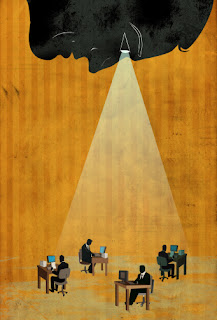Slips
and falls are not only the largest source of injuries in the home; they also
occupy the lion’s share of reported injuries in public venues like grocery
stores, shopping malls and restaurants. They are also prominent in the
construction trades. More important,
they are most often reported in relation to day workers, temporary workers, or
seasonal workers, who are at best semi-skilled.
Slips,
trips and falls, notes OSHA (the Occupational Health and Safety Administration,
a division of the Department of Labor), comprise the majority of general
industry accidents as well; “general industry” meaning all the across-the-board
enterprises which make, refine, or ship and deliver industrial, consumer and
business products around the nation.
Workers
slipping, tripping or falling while in the workplace performing a salaried or
by-the-hour job contribute 15 percent to the total of all accidental deaths in
the United States. This is true in spite of OSHA standards which dictate the
quality and nature of walking or working surfaces, excluding only domestic
care, mining, and agricultural labor, where application of such safety
standards would be difficult or impossible.
The
most common injuries from slip-and-fall scenarios are:
- Broken bones, particularly leg and foot bones, and secondarily hip bones in older individuals
- Cuts, if the slip causes an individual to fall on a sharp object
- Contusions, or bruises, which can be both disfiguring and quite painful, but rarely lethal unless the contusion involves the head
- Head injuries, which can lead to confusion, neurological disturbances, concussions, comas or complete amnesia for a certain period
- Death, which comprises 20,000 of the fatalities reported in the United States each year
These
standards, besides being specific for overall industrial production under
OSHA’s rulemaking standard, 29 CFR 1910, also define proper walking or working
surfaces at ship yards and ports where marine passengers or cargo deliveries
debark or disembark. Longshoremen, or workers who remove or load cargo
containers from ships, are provided the same safety standards, as are
construction workers.
In
addition to federal standards, 25 states plus Puerto Rico and the Virgin
Islands have their own, OSHA-approved requirements, and one would think this
dual layer of protection for workers would cut slip, trip and fall accidents to
the bare minimum.
This
is simply not so, especially in the construction trades, largely because the
range of hazards – starting with general clutter and including damaged ladder
steps; faulty scaffolding; dangling or foot-grabbing electrical cords;
substandard cords; grease, water or ice on the floor; loose tile or carpeting;
open desk drawers, filing cabinet drawers and other access doors; and heavily
polished floors or uneven flooring surfaces (including floors that abruptly
change levels via a single step, for example) – is so much greater and more
complex than any agency’s ability to elucidate them or any individual’s ability
to remedy them.
For
example, in cold climates the possibility of snow or ice, hail, or snowstorms
rapidly followed by sunlight and temperatures warm enough to melt snow (which
re-freezes again after nightfall) are an unremitting, 24-hours-per-day job. For
small companies with only one or two maintenance workers, or for large
companies with many properties, it is inevitable that some slippery surfaces will not be remedied before someone
falls.
At
construction sites, that someone is likely to be underskilled, ESL (English as
a Second Language), and likely from a much warmer climate. Thus even when
things like substandard extension cords – often rated by Underwriters
Laboratories (UL) for nothing more than 120-volt service yet used to operate
heavy equipment – are labeled “peligro (danger)!”, the danger is not defined,
so workmen ignore it.
Additional
dangers, according to OSHA, involve cutouts in the floor for plumbing
connections, electrical connections or other building service elements. When
these are left open instead of being covered with the industry-standard
toe-board (a cause of trips in itself), the result is inevitable.
A
lack of toe-boards and guard rails to protect workers from hazardous machinery
or equipment – even where said equipment is taller than the average male – is
another commonly overlooked safety hazard. Final hazards include the failure of
companies, managers or crew bosses to hand out essential safety equipment like
anchored safety harnesses, nets, or railings. The other hazard is workmen
failing to ask for them.
Some
employers, supervisors and job foremen do their best to educate workers about
job dangers, but many don’t speak Spanish or any Asian or African dialects, which
means the workers who are most vulnerable don’t get any instruction, including printed materials.
If
you (or a friend) are aware of existing safety violations, or if someone you
know has been injured as a result of the company failing to observe even
minimal safety standards, you can contact OSHA and a representative will visit
your place of work.
The
downside for you, the worker, is that if you sign the complaint form, an angry
boss or foreman may fire you, whereas if you don’t, the agency may not take you
seriously and fail to send anyone. There
are remedies for getting fired under these “whistleblower” circumstances, but
they take time, so be sure you are ready to go the distance before you mail or
fax your written and signed complaint. In the end, your best bet may be to
consult a lawyer, who will handle the more subtle nuances of personal injury
law.


0 comments:
Post a Comment